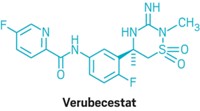Advertisement
Grab your lab coat. Let's get started
Welcome!
Welcome!
Create an account below to get 6 C&EN articles per month, receive newsletters and more - all free.
It seems this is your first time logging in online. Please enter the following information to continue.
As an ACS member you automatically get access to this site. All we need is few more details to create your reading experience.
Not you? Sign in with a different account.
Not you? Sign in with a different account.
ERROR 1
ERROR 1
ERROR 2
ERROR 2
ERROR 2
ERROR 2
ERROR 2
Password and Confirm password must match.
If you have an ACS member number, please enter it here so we can link this account to your membership. (optional)
ERROR 2
ACS values your privacy. By submitting your information, you are gaining access to C&EN and subscribing to our weekly newsletter. We use the information you provide to make your reading experience better, and we will never sell your data to third party members.
Pharmaceuticals
Revisiting 2007 and 2009 Disclosures
Medicinal chemists debut five drug candidates and describe their discovery.
by Carmen Drahl
April 16, 2012
| A version of this story appeared in
Volume 90, Issue 16
At the spring 2007 ACS national meeting, Merck Research Laboratories revealed the structure of MK-0974, later known as telcagepant, an experimental treatment for migraine (C&EN, May 7, 2007, page 56). And in 2009, the company unveiled MK-3207, for the same indication (C&EN, April 27, 2009, page 31). Both molecules block the receptor for calcitonin gene-related peptide (CGRP), a neuropeptide implicated in migraine. Both were proven efficacious at treating migraines in patients. And both failed to reach the market.
In September 2009, Merck announced it was abandoning MK-3207 because some study subjects had liver test abnormalities, generally after stopping treatment. And in July 2011, it terminated telcagepant after an assessment of data from across the molecule’s clinical program, including a Phase III trial. The company had previously put telcagepant on hold when it found elevated liver transaminase enzymes in some patients who took it.
Two other CGRP receptor inhibitors have not budged beyond clinical trials—olcegepant, which according to information services firm Thomson Reuters has been discontinued, and BI 44370 TA, the status of which is unknown. Both are from Boehringer Ingelheim. But researchers are still plugging away at the target. At this spring’s meeting, Bristol-Myers Squibb reported BMS-927711, which is currently the only CGRP inhibitor in active clinical trials. And at a poster session at the meeting, Ian M. Bell, the Merck medicinal chemist who unveiled MK-3207 three years ago, reported MK-8825, a CGRP antagonist with oral activity in rats.
One of the issues with developing CGRP inhibitors has been that molecules that worked for humans and primates haven’t been effective for rats. This makes it hard to use rat models early in development. Bell’s team made subtle tweaks to MK-3207 that lowered its binding to rat plasma proteins but maintained the compound’s moderate affinity for the rat CGRP receptor, arriving at MK-8825. “We hope that MK-8825 will prove to be a useful tool compound for studies in rats,” Bell said. With more work, he added, it might even untangle more of the complex biology of CGRP and migraine.






Join the conversation
Contact the reporter
Submit a Letter to the Editor for publication
Engage with us on Twitter